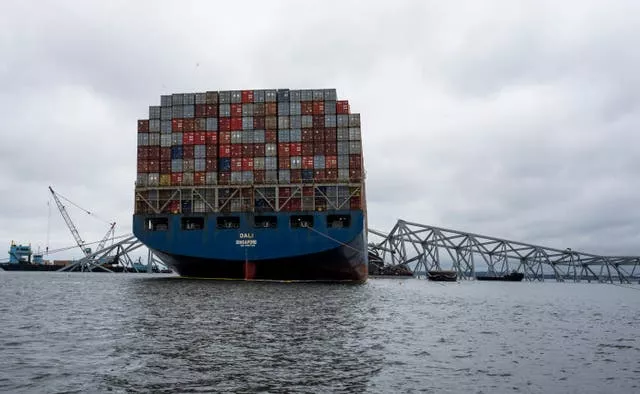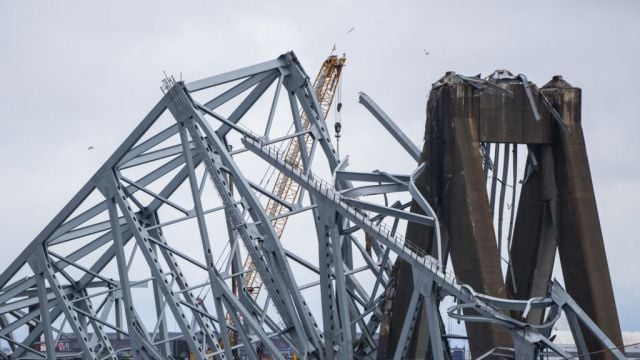A tugboat pushing a fuel barge was the first vessel to use an alternate channel to bypass the wreckage of Baltimore’s collapsed Francis Scott Key Bridge, which had blocked traffic along the vital port’s main shipping channel.
The barge supplying jet fuel to the Department of Defence left late on Monday and was destined for Delaware’s Dover Air Force Base, though officials have said the temporary channel is open primarily to vessels that are helping with the cleanup effort.
Some barges and tugs that have been stuck in the Port of Baltimore since the collapse are also scheduled to pass through the channel.
Officials said they are working on a second channel on the south-west side of the main channel that will allow for deeper draught vessels, but they did not say when that might open.
Governor Wes Moore is set to visit one of two centres that the Small Business Administration opened in the area to help companies get loans to assist them with losses caused by the disruption of the bridge collapse.

In Annapolis, a hearing is scheduled on Tuesday for a bill authorising the use of state reserves to provide financial assistance to port employees who are out of work because of the bridge collapse.
Lawmakers are working to pass the bill quickly in the last week of their legislative session, which ends Monday.
Crews are undertaking the complicated work of removing steel and concrete at the site of the bridge’s deadly collapse after a container ship lost power and crashed into a supporting column.
On Sunday, dive teams surveyed parts of the bridge and checked the ship, and workers in lifts used torches to cut above-water parts of the twisted steel superstructure.
Authorities believe six workers plunged to their deaths in the collapse, including two whose bodies were recovered last week. Two other workers survived.
Mr Moore, a Democrat, said at a Monday afternoon news conference that his top priority is recovering the four remaining bodies, followed by reopening shipping channels.
He said that he understands the urgency but that the risks are significant. Crews have described the mangled steel girders of the fallen bridge as “chaotic wreckage”, he said.
“What we’re finding is it is more complicated than we hoped for initially,” said US Coast Guard Rear Admiral Shannon Gilreath.
Meanwhile, the ship remains stationary, and its 21 crew members remain on board for now, officials said.
President Joe Biden is expected to visit the collapse site on Friday to meet with state and local officials and get at federal response efforts.
The bridge fell as the cargo ship Dali lost power March 26th shortly after leaving Baltimore on its way to Sri Lanka. The ship issued a mayday alert, which allowed just enough time for police to stop traffic, but not enough to save a roadwork crew filling potholes on the bridge.
The Dali is managed by Synergy Marine Group and owned by Grace Ocean Private Ltd, both of Singapore. Danish shipping giant Maersk chartered the Dali.
Synergy and Grace Ocean filed a court petition on Monday seeking to limit their legal liability, a routine but important procedure for cases litigated under US maritime law.
A federal court in Maryland will ultimately decide who is responsible and how much they owe.
The filing seeks to cap the companies’ liability at roughly 43.6 million dollars. It estimates that the vessel itself is valued at up to 90 million dollars and was owed more than 1.1 million dollars in income from freight.
The estimate also deducts two major expenses: at least 28 million dollars in repair costs and at least 19.5 million dollars in salvage costs.
Officials are trying to determine how to rebuild the major bridge, which was completed in 1977. It carried Interstate 695 around south-east Baltimore and became a symbol of the city’s working-class roots and maritime culture.
Congress is expected to consider aid packages to help people who lose jobs or businesses because of the prolonged closure of the Port of Baltimore. The port handles more cars and farm equipment than any other US facility.







